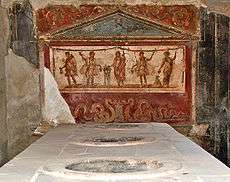Thermopolium
In the ancient Greco-Roman world, a thermopolium (plural thermopolia), from Greek θερμοπώλιον (thermopōlion), i.e. cook-shop,[1] literally "a place where (something) hot is sold", was a commercial establishment where it was possible to purchase ready-to-eat food. In Latin literature, they would also be called popina, caupona, hospitium or stabulum, but archaeologists call them all thermopolium[2]. The forerunner of today's restaurant, the items served at the thermopolia are sometimes compared to modern fast food. These places were mainly used by those who simply could not afford a private kitchen, often inhabitants of insula (building), sometimes leading them to be scorned by the upper class.
Design
A typical thermopolium would consist of a small room attached but not accessible to a house with a distinctive masonry counter in the front[3]. An example of this can be seen in Ostia in the House of the Painted Vaults. Embedded in this counter were earthenware jars (called dolia) used to store dried food like nuts (hot food would have required the dolia to be cleaned out after use, and because they are embedded in the counter, it is believed that they were not used to store hot food, but rather dried food where cleaning wouldn't be necessary)[4]. A dolium in the thermopolium attached to the House of Neptune and Amphitrite in Herculaneum had the carbonized remains of nuts[5]. Fancier thermopolia would also be decorated with frescoes.
Well-preserved ruins of thermopolia can be seen in Pompeii, Herculaneum and Ostia.
Thermopolium of Asellina

The Thermopolium of Asellina is one of the most complete examples of a thermopolium in Pompeii. Complete jugs and dishes were found on the counter, as well as a kettle filled with water. The ground floor in the Thermopolium of Asellina was used for people to eat and drink, and some stairs led to guest rooms on the second floor [6].
It had a typical structure consisting of a wide doorway open to the street, a counter with holes where four jars were set into it (dolia) for food or wine. It had shrines for the Lares (household gods), Mercury (god of commerce) and Bacchus (god of wine), as these were the most important gods for this occupation. Upstairs, there were guest rooms as well, so this may have also been used as an Inn; however, some think that this may have been a brothel due to the names of many women written as a part of an election notice on one of the outsidewalls of the Thermopolium. Another theory is that these were the slave-girls who worked as barmaids. Behind the bar were remains of wooden racks suspended from the ceiling to stack amphorae[7].
Further reading
- Ellis, Steven J. R. (2004). "The Distribution of Bars at Pompeii: Archaeological, Spatial and Viewshed Analyses". Journal of Roman Archaeology. 17: 371–384. doi:10.1017/s104775940000831x. ISSN 1047-7594.
References
- θερμοπώλιον. Liddell, Henry George; Scott, Robert; A Greek–English Lexicon at the Perseus Project
- Berry, Joanne (2007). The Complete Pompeii. London: Thames and Hudson. p. 230. Retrieved 13 June 2020.
- Clarke, Andrew (1991). The Houses of Roman Italy, 100 B.C.-AD 250. Berkley: The University of California Press. p. 297. Retrieved 13 June 2020.
- Berry, Joanne (2007). The Complete Pompeii. London: Thames and Hudson. p. 230. Retrieved 13 June 2020.
- Berry, Joanne (2007). The Complete Pompeii. London: Thames and Hudson. p. 230. Retrieved 13 June 2020.
- Berry, Joanne (2007). The Complete Pompeii. London: Thames and Hudson. pp. 231–232. Retrieved 13 June 2020.
- Berry, Joanne (2007). The Complete Pompeii. London: Thames and Hudson. p. 230. Retrieved 13 June 2020.
- Claridge, Amanda; Ward-Perkins, John (1978). Pompeii AD 79. New York: Alfred Knopf. p. 87.
External links
| Wikimedia Commons has media related to thermopolium. |